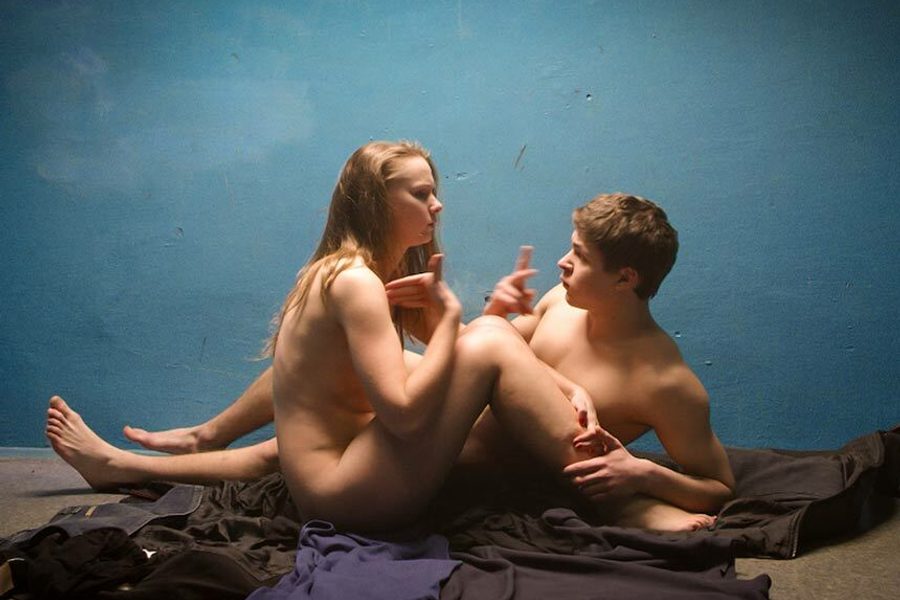The Tribe Is a Silent Lord of the Flies
Though entirely in Ukrainian Sign, without subtitles, Slaboshpytskiy’s remarkable film will speak to a hearing audience.
Michael Atkinson

It will undoubtedly be the strangest, most unforeseen coup de cinema of 2015 — a film entirely about Deaf teenagers, their life of signing presented without subtitles. But Ukrainian director Myroslav Slaboshpytskiy’s debut film, The Tribe, is no stunt. The film is essentially silent, an experience of eruptive human narrative structured by a language the vast majority of its audience will not understand. Even the American Sign Language literate will comprehend only a fraction of the Ukrainian system. As for the rest of us, we are pure observers, just as we are in real life — leaning in, alert to mysterious human behavior. Of course, even absent the convenience of spoken communication, we understand what’s happening all too well. Taking place largely within the walls of a dilapidated Ukrainian boarding school for the Deaf, the film is a harrowing portrait of social collapse and hierarchal abuse, writ miniature.
Slaboshpytskiy begins his exploration traditionally: We follow one lad, Sergey (Grigoriy Fesenko), as he finds his way to the school, suitcase in hand. At the beginning of 34 long roving shots that take up to six minutes each, Sergey tries to fit into the school’s bully-code social order, getting quickly robbed, slapped around, intimidated, and kicked out of his dorm bed. The school’s teaching staff vanish from the film after the first few sequences; like the grown-ups in Peanuts, they’re irrelevant.
But Sergey is no pushover, quickly proving himself as potentially criminal as those around him. He is taken into the fold, though it’s clear no one is ever truly safe.
Then we are brought deeper into the students’ underground lifestyle, which includes muggings, burglary and pimping out two girls at the local truck stop. After one of the boys is killed in a hair-raising accident ingeniously and convincingly linked to deafness, Sergey is assigned pimping duties, and he suddenly musters a rebellious yen for one of the girls (Yana Novikova). This chink in the shaky gearwork of the kids’ Clockwork Orange-y way of life sends things spinning, setting off the tragic fall of dominoes that climaxes with the force of a thunderclap.
The Tribe isn’t merely its own story, nor is it a film about disability, or belonging to the Deaf community. To a startling degree, it rejiggers the act of watching cinema. Language itself is the issue under question — how helpless are we without it? Slaboshpytskiy’s strategy, including his long takes that emphasize nothing in particular (no close-ups), is to disrupt our natural craving for narrative omniscience. We want to understand the details, because that way we’re secure in our knowledge of the story’s parameters. But that is forbidden by this movie’s procedural realism. (What’s less realistic than subtitles?) In a traditional silent film, we know we will be told what is essential; the absence of language was something the medium worked around, often poetically. But here we know no such thing — we are on the edge of crisis, trying to fathom the action as it spirals out of control.
A viewer trained in Ukrainian Sign might have a different reaction. But for the rest of us, this movie is an uncanny realignment. None of The Tribe’s ensemble cast are professional actors. None need to be — performance and clarified visual expression is inherent in signing. (Eye contact is paramount — emphatic yowls of fury or fear go unrecognized unless you’ve made sure someone is looking at you.) For the first time in movies, we witness the expression of wild psychodramatic emotion in utter quiet, with little but the rustle of fast-moving hands to fill the rooms. It’s not a film made for the Deaf — we’re meant to hear it all, even if no value is placed on sound. In one scene that’s almost unbearable to watch (you know Slaboshpytskiy won’t cut away, and he doesn’t), we finally hear a voice forced out — a choked wail of suffering.
For a hearing audience it’s fascinating to watch The Tribe, troublesome thing that it is, as a work of outlandish metaphor. Our emotional distance from — and helpless incomprehension of — these punks scans like an extreme version of how far we are from teenagers generally, or ethnic Others wherever they may live, or just other people, period. It’s a movie Samuel Beckett would have loved, exploding with language but existentially acknowledging both how little is communicated and how much humanity we share regardless.









